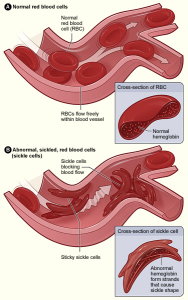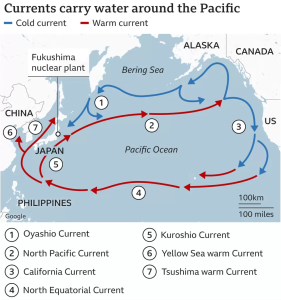Mains – 15th Nov 23
National Sickle Cell Anaemia Eradication Mission (NSCAEM)
Why in news?
- PM launched National Sickle Cell Anaemia Eradication Mission (NSCAEM) 2047 by unveiling a portal in Shahdol, Madhya Pradesh.
What is Sickle Cell Anaemia?
- First discovered by a physician named James Herrick, Sickle cell disease is a genetic blood disease which affects the whole life of affected patient. It not only causes anemia but also reduced growth, and affects many organs like lungs, heart, kidney, eyes, bones and the brain.
- World Sickle Cell Day is observed every year on June 19.
What happens in Sickle Cell Anaemia?
- It affects the shape of red blood cells, which carry oxygen to all parts of the body. Red blood cells contain hemoglobin, a protein that carries oxygen.
- Healthy red blood cells are round, and they move through small blood vessels to carry oxygen to all parts of the body, but sickle red blood cells end up slowing and even blocking, the blood flow.
- Moreover, sickle cells die early, resulting in a shortage of red blood cells that deprive the body of oxygen. These obstructions and shortages may cause chronic anaemia, pain, fatigue, acute chest syndrome, stroke, and a host of other serious health complications.
- In someone who has SCD, the hemoglobin is abnormal, which causes the red blood cells to become hard and sticky and look like a C-shaped farm tool called a sickle.

Is it possible to treat Sickle Cell Anaemia?
- Sickle cell anaemia is a genetic disorder, the only cure comes in the form of gene therapy and stem cell transplants — both costly and still in developmental stages.
- In gene therapy, the DNA inside the haemoglobin gene is edited to stop the disease.
- In stem cell transplants, the bone marrow affected by sickle cell anaemia is replaced with healthy bone marrow from a donor.
- Blood transfusion, wherein red blood cells are removed from donated blood and given to a patient, is also a trusted treatment in the absence of permanent cures. But challenges include a scarcity of donors, fears around safe supply of blood, risk of infection etc.
National Sickle Cell Anaemia Elimination Mission:
The programme was first announced in the Union Budget 2023.
- To improve care of all Sickle Cell Disease patients for their better future and to lower the prevalence of the disease through multi-faced coordinated approach towards screening and awareness strategies
- Eliminate sickle cell disease as a public health problem in India before 2047.
- The overall aim is to enable access to affordable and quality health care to all SCD patients, and to lower the prevalence through awareness, change of practices and screening interventions.
- Beneficiaries: The program will cover the entire population from zero to 18 years of age and shall incrementally include the entire population up to 40 years. Over a period of three years, spanning from the fiscal year 2023-24 to 2025-26, the program targets screening approximately 7.0 crore people.
- The strategy emphasizes on THREE pillars:
- Health promotion– Awareness generation & pre-marital genetic counselling
- Prevention: Universal screening and early detection
- Holistic Management & continuum of care–
- Management of persons with sickle cell disease at primary, secondary and tertiary health care levels; treatment facilities at tertiary health care facilities
- Patient support system
- Community adoption
Implementation: The programme will be executed as part of the National Health Mission (NHM) and in integration with existing mechanism under NHM such as Rashtriya Bal Swasthya Karyakram (RBSK) and Pradhan Mantri Surakshit Matritva Abhiyan (PMSMA).
Status of Sickle Cell Anaemia in In India:
- India is the second-worst affected country in terms of predicted births with SCA — i.e., chances of being born with the condition.
- In India, around 18 million people have sickle cell traits and 1.4 million patients have sickle cell disease.
- In India, it is more common in the tribal population where about 1 in 86 births among STs have SCD, but occurs in non-tribals too.
- India has the largest density of tribal population, globally. As per Census 2011, India has an 8.6% tribal population which is 67.8 million across the Indian states.
- A few states in India have a significantly higher SCD prevalence. These include: Chhattisgarh, West Bengal, Uttar Pradesh, Maharashtra, Madhya Pradesh, Jharkhand, Gujarat, Odisha, Kerala and Rajasthan. Collectively, these states are referred to as the sickle cell belt.
Steps taken by India:
- Ministry of health under NHM initiated the work on hemoglobinopathies (Thalassemia & Sickle Cell Disease) in 2016 wherein comprehensive guidelines on prevention and management of heamoglobinopathies were released and provision of funds towards screening and management of Sickle cell disease were made.
- The Ministry of Tribal Affairs (MoTA) has launched the Sickle Cell Disease Support Corner to bridge the gap between patients and health care services in tribal areas.
- The National Council on Sickle Cell Disease has also been constituted for timely and effective action.
- In the Budget 2023-24, the government announced its plans to distribute “special cards” across tribal areas to people below the age of 40. The cards will be divided into different categories based on the screening results. The mission will receive funding under the National Health Mission.
What should be the way forward?
- Increasing the awareness about the disease in the community.
- Implementation of mass screening activities for early identification.
- Building a strong network of diagnosis and linkages.
- Implementing robust monitoring system.
- Strengthening the existing primary health care mechanism to incorporate SCD related strategies.
- Capacity building of primary, secondary and tertiary health care teams.
- Building cost-effective intensive interventions at higher care facilities
Fukushima Water Issue
Why in news?
Japan’s controversial plan to release treated waste water from the Fukushima nuclear plant into the Pacific Ocean has sparked anxiety and anger at home and abroad.
Fukushima Disaster
- The Fukushima Daiichi Nuclear power plant suffered a meltdown in 2011 after a massive earthquake and tsunami, releasing large amounts of radioactive materials into the environment.
- Since the disaster, power plant company Tepco has been pumping in water to cool down the Fukushima nuclear reactors’ fuel rods. This means every day the plant produces contaminated water, which is stored in massive tanks.
- More than 1,000 tanks have been filled, and Japan says that it needs the land occupied by the tanks to build new facilities to safely decommission the plant. It has also pointed out concerns that the tanks could collapse in a natural disaster.
- Releasing treated waste water into the ocean is a routine practice for nuclear plants – though critics have pointed out that the amount from Fukushima is on an unprecedented, far vaster scale.
- Though Japan filters the Fukushima water which reduces most radioactive substances to acceptable safety standards, apart from tritium and carbon-14. Tritium and carbon-14 are, respectively, radioactive forms of hydrogen and carbon, and are difficult to separate from water. They are widely present in the natural environment, water and even in humans, as they are formed in the Earth’s atmosphere and can enter the water cycle.
Viewpoint of Critics
- Critics say Japan should, for the time being, keep the treated water in the tanks. They argue this buys time to develop new processing technologies, and allow any remaining radioactivity to naturally reduce.
- China has been the most vocal, accusing Japan of violating “international moral and legal obligations” and “putting its selfish interests above the long-term wellbeing of the entire humanity”.

International Atomic Energy Agency
- IAEA is an intergovernmental organization that seeks to promote the peaceful use of nuclear energy and to inhibit its use for any military purpose, including nuclear weapons.
- It was established in 1957 as the world’s “Atoms for Peace” organization within the United Nations family, and governed by its own founding treaty, the Statute of the IAEA.
- It reports to both the UN General Assembly and the UN Security Council, and is headquartered at the UN Office at Vienna, Austria
- In 2005, it was awarded the Nobel Peace Prize for their work for a safe and peaceful world.
